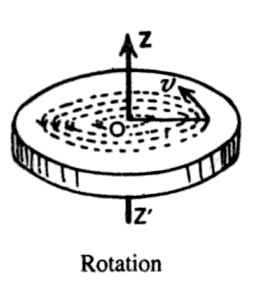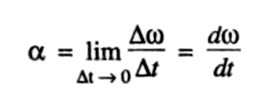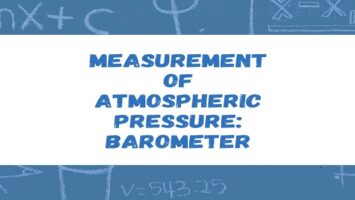Kinematical Terms:
Rotational motion is almost as common in our daily life as translational motion. The wheels, spinning tops, blades of a fan, and phonograph records all perform rotational motion. In a pure rotational motion, a body does not move from one place to another, it simply turns through a certain angle. Thus
“A body is said to perform a pure rotational motion if every particle in the body moves in a circular path such that the centres of these circles lie on a straight line called the axis of rotation.

However, in our daily lives, we find several examples where bodies describe translational and rotational motion simultaneously. For example, the wheel of a car rotates about its axle as well as covers a certain linear distance. The earth rotates about an axis passing through it and at the same, it revolves around the sun, thus it has both the rotational and the translational motions.
In more complicated cases, the axis of rotation may change in direction with time. However, we shall confine only to simple cases of rotation of a rigid body about a fixed axis.
If a body is constrained to rotate about a fixed axis, the constituent particles P1, P2, …., Pn of the body undergo circular motion about the axis of rotation. Let the radii of the circular path be r1, r2, …., rn.
Although the rotating body as a whole does not move, its constituent particles cover linear distances along the circular paths. Thus as far as the motion of the constituent particles is concerned it can be described either in terms of linear quantities or angular quantities. However, the rotational motion of the whole body can only be described in terms of angular quantities like angular displacements, angular velocity, and angular acceleration.
(1) Angular Displacement- The angular displacement of the body is the angle by which a line in the body turns with reference to some fixed line in space. It is represented by the symbol θ.
All points of a rigid body turn through the same angle, i.e., the angular displacement θ of one particle is the same as that of any other particle, but the linear distance covered by different particles, in general, are different- a particle farther away from the axis describes larger linear distance than a particle near the axis. We know that for a particle P moving in an arc of radius r, the linear distance s covered is given by
| s = rθ |
(2) Angular Velocity- The rate of change of angular displacement is known as angular velocity. Thus if a rotating body turns through an angle Δθ in time Δt, its angular velocity ω is given by

The angular velocity of a rotating body is a vector quantity and it acts parallel to the axis of rotation and its sense is given by the right-hand rule. According to the right-hand rule, if we grasp the axis of rotations with the right hand so that the fingers are curled in the sense of rotation, the extended thumb then points in the direction of ω.

All particles of the body rotate with the same angular velocity, but their speeds are different. Thus the linear speed ν of a particle moving in a circular path of radius r is given by

(3) Angular Acceleration- If the angular speed of a rotating body changes with time, it has some angular acceleration. The angular acceleration is the rate of change of angular velocity. The angular acceleration is written by the symbol α. Thus

The angular acceleration is a vector quantity and is directed along the axis in the same direction as ω when the angular velocity is increasing but opposite to ω when it is decreasing.
All particles of the rotating body have the same angular acceleration but their linear tangential acceleration aT are different. For a particle P moving in a circular path of radius r, since ν = rω, we find the tangential acceleration aT responsible for changing the magnitude of the linear speed as given by

It is to be noted that the tangential acceleration a (= r dω/dt) represents the change in the magnitude of the linear velocity while the centripetal acceleration ac (= ω2r) represents the change in the direction of motion. Particles moving in circular motion are always subjected to centripetal acceleration but they experience tangential accelerations only when they are moving with variable angular speed.









Comments (No)